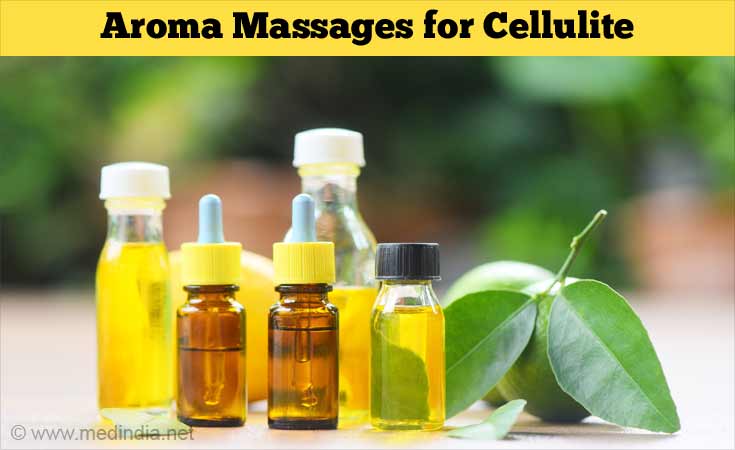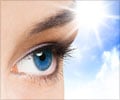- Adis Medical Writer. Cellulite: no clear evidence that any type of treatment is effective. Drugs & Therapy Perspectives 2015 Dec; 31(12):437-440
- Luebberding S, Krueger N, Sadick NS. Cellulite: An Evidence-Based Review. Am J Clin Dermatol. 2015;16(4):243–56
- Emanuele E. Cellulite: advances in treatment: facts and controversies. Clin Dermatol. 2013 Nov-Dec;31(6):725-30
- G Sivagnanam. Mesotherapy – The french connection. J Pharmacol Pharmacother. 2010 Jan-Jun; 1(1): 4–8.
- Adatto M, Adatto-Neilson R, Servant J-J, Vester J, Novak P, Krotz A. Controlled, randomized study evaluating the effects of treating cellulite with AWT/EPAT. J Cosmet Laser Ther. 2010;12(4):176–82.
- Russe-Wilflingseder K, Russe-Wilfingsleder K, Russe E, Vester JC, Haller G, Novak P, Krotz A. Placebo controlled, prospectively randomized, double-blinded study for the investigation of the effectiveness and safety of the acoustic wave therapy (AWT) for cellulite treatment. J Cosmet Laser Ther. 2013;15(3):155–62.
- Kutlubay Z, Songur A, Engin B, Khatib R, Calay O¨, Serdarog˘lu S. An alternative treatment modality for cellulite: LPG endermologie. J Cosmet Laser Ther. 2013;15(5):266–70.
- Dupont E, Journet M, Oula M-L, Gomez J, Le´veille´ C, Loing E, Bilodeau D. An integral topical gel for cellulite reduction: results from a double-blind, randomized, placebo-controlled evaluation of efficacy. Clin Cosmet Investig Dermatol. 2014;7:73–88.
What is Cellulite?
Cellulite is a condition where the skin has a dimpled appearance due to more than normal fat accumulation beneath the skin. Cellulite is also known as 'orange peel syndrome' or 'cottage cheese skin'.
Women are more susceptible to develop cellulite than men.
One of the main reasons could be that women in general have a higher percentage of body fat than men which is mainly stored in the hips and thighs. Men store their fat mostly in the abdomen. These factors coupled with the fact that a man’s skin is thicker than a woman make cellulite more pronounced in women. 85 - 90% of post adolescent women are known to develop cellulite.
Cellulite is not harmful but most people want to get rid of it for cosmetic purposes.
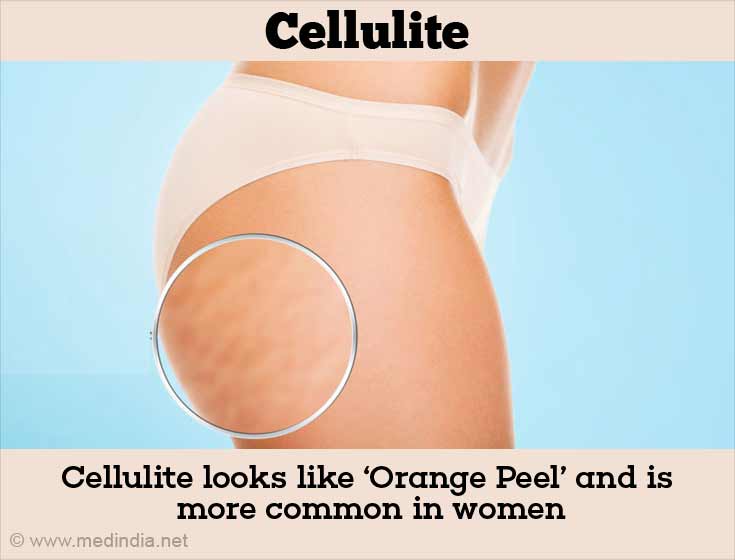
What are the Causes of Cellulite?
The area that is affected by cellulite is the subcutaneous layer of the skin or the dermis. This is the layer right below the top layer of the skin.
To understand what causes cellulite and how the various treatments work, we first need to understand the structure and function of the dermis.
The dermis contains a network of fibrous connective tissues that provide elasticity and tensile strength to the skin. These connect the skin to the muscle layer below. The individual components of the connective tissues are collagen (that provides strength) , elastic fibers (that provide elasticity), lymphatic and blood vessels (responsible for providing nourishment and removal of toxins), fat producing cells or adipocytes among other things.
Simply put, when fat cells grow or increase they push the skin outwards while the long, tough connective tissues get pulled downwards. This causes uneven or bumpy surfaces on the skin called dimples.
Apart from an enlargement or overgrowth of fat cells, other underlying causes that contribute to cellulite are:
- Reduced microcirculation
- Edema
- Oxidative stress
- Low grade inflammation
- Alterations in the extracellular matrix
- Abnormality in the elasticity and resilience of the skin
Thus cellulite treatment methods work by affecting one or more of the above causes.
What are the Risk Factors of Cellulite?
- Gender - women are more likely to develop cellulite than men on account of having more fat around their thighs, hips and buttocks
- Age - as the skin loses some of its elasticity
- Genetics
- Body weight - although cellulite can affect lean and heavy people alike it is more noticeable in the later population
- Stress
- Hormonal imbalance
- Distribution of subcutaneous fat
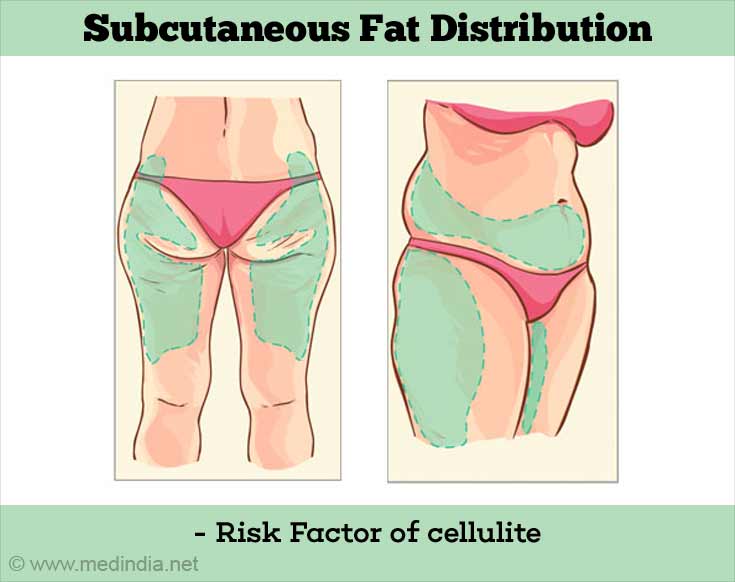
How do you Treat Cellulite?
An article in Drug and Therapy Perspectives (2015) states that as of now there is no clear clinical evidence for efficacy of cellulite treatments and that most of them provide only temporary relief.
However here are the methods most sought after:
1. Cellulite Laser Treatment
The non-invasive laser treatment delivers thermal energy into the deep dermis and hypodermis and generates a wound-healing response. The result being that new collagen is formed that compresses fat and improves cellulite appearance.
However, the minimally invasive laser technique with its FDA - approved brand names like Cellulaze and CelluSmooth is fast acquiring popularity. The technique requires only one sitting and is more effective that the non-invasive method. It is placed subdermally and uses side-firing lasers. This laser technique -
- Selectively melts hypodermal adipocytes thus smoothening out the uneven dermal-hypodermal interface
- Severes the region (septae bands) that connects the dermal and muscle layers (hypodermal) by thermal subcision
- Heats the dermis to increase its thickness and skin elasticity (achieved by remodeling and forming new collagen)
A smoother contour, increased skin elasticity and dermal thickness have been observed using this technique although bruising and swelling side effects can be considered as drawbacks. The cost of this method is around $5000-7000 depending on the area affected.
2. Acoustic Wave Therapy (AWT)
This technique uses focused or radial waves and is supposed to improve local blood circulation and increase cell proliferation and of collagen and elastin fibers to increase skin elasticity. They break up the septae bands that pull down the skin.
Two recent studies (conducted in Switzerland in 2010 and Austria in 2013 and both published in Journal of Cosmetology Laser Therapy showed AWT to be a safe and effective treatment method in temporary relief of cellulite.
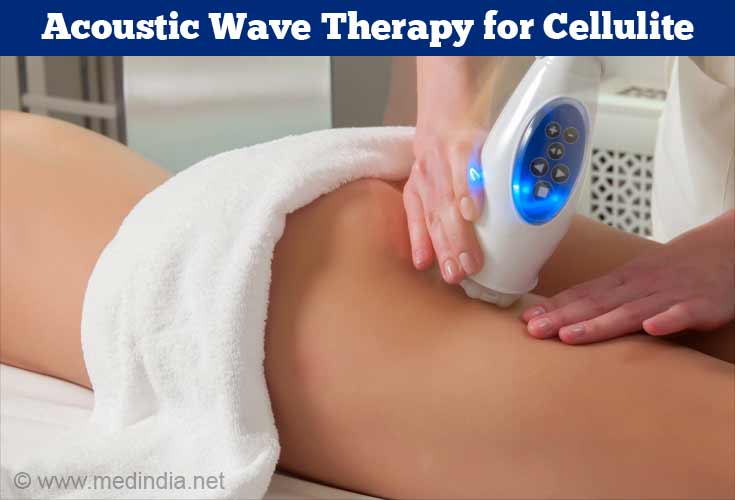
3. Cellulite Creams
Topical treatments or cosmetics for cellulite include cellulite creams.
Cellulite creams contain like caffeine, retinol, carnitine, forskolin and other botanical derivatives. Caffeine could be substituted by aminophylline (a prescription drug to treat asthma) or theophylline.
The broad therapeutic effect of cellulite creams is through adipocyte tissue lipolysis, peripheral microcirculation stimulation that facilitates lymphatic drainage, and edema reduction.
Particular ingredients act in the following ways:
- Caffeine: Causes breakdown of fat cells through regulation of biological second messenger systems. Also activates the triglyceride lipase enzyme instrumental in breaking down triglycerides into free fatty acids and glycerol.
- Retinol Formulations: Act as anti-adipogenic agents and block the differentiation of human adipocyte precursor. Also boost collagen levels. This improved skin thickness and its elastic / tensile properties.
- Potent Botanicals (Gingko biloba, Centella asiatica, and horse chestnut): Slow down lipogenesis, activates fat breakdown, and act as antioxidants with anti-inflammatory effects.
Various combinations of anti-cellulite agents have been experimented so far.
A recent study conducted in Canada compared 44 women who applied either an active product or placebo for 3 months. This study published in the journal of Clinical, Cosmetic and Investigational Dermatology showed a significant improvement in cellulite grade and circumference as compared to the control. Skin tonicity, orange-peel appearance, and stubborn cellulite were all significantly improved at day 84.
Cost for cellulite cream treatments is generally US $5 to $50 and up.

4. Liposuction
Liposuction removes excess fat underneath the skin (on hips, abdomen, thighs, buttocks and face) through tiny incisions. This could be combined with a laser technique that also tightens the skin.
Many people with cellulite might undergo a liposuction surgery to get rid of the unwanted fat but should realize that they may not necessarily benefit from liposuction as it does not remove cellulite. On the other hand this cellulite surgery could be detrimental as it can cause skin irregularities. Other common side effects of liposuction in general include temporary swelling, itching, and discoloration, not to forget an average cost estimate of around $ 2500.
5. LPG Endermologie
The LPG (Louis Paul Guitay) endermologie is a patented FDA approved massage treatment that kneads the skin and provides temporary reduction of cellulite. It uses an electrically powered hand-held device that uses two rollers to cause rhythmical folding and unfolding of the dermis. A “deep massage” of this nature stimulates microcirculation, aids in lymph drainage and damages the subcutaneous fat. The fat when healing gets evenly distributed thus smoothing the skin out.
A comprehensive result from six studies published in various journals (Int J Dermatol. - 2009, Clin Cosmet Investig Dermatol - 2011, Journal of Cosmetology Laser Therapy. - 2013;Dermatol Res Pract. - 2012) evaluated the effect of LPG Endermologie on cellulite.
Although observations showed an improvement in cellulite grading and a reduction in thigh circumference none of these studies had incorporated a placebo or an untreated control. Hence the efficacy of the method is to be viewed with caution.
The LPG Endermologie treatment costs are $100 and up per session.
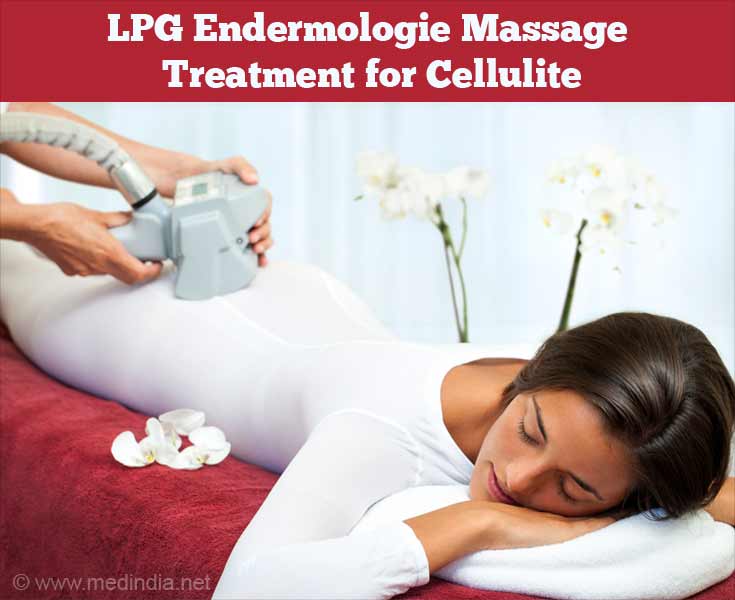
6. Radiofrequency (RF)
This technique causes a thermally mediated reaction (dependent on the resistance level of the tissue) in the dermis. The heat produced is absorbed by the adipocytes that causes break down of fat cells through membrane lysis. It also causes collagen denaturation resulting in tightened tissues.
Overall, high frequency or Radiofrequency in combination with Infrared and / massage did not show any significant treatment success.
The cost range for RF treatment is About $400 a session.
7. Other laser and light-based techniques
- Low level laser therapy (LLLT) uses lasers in the milliwatt power range and induces a biological cascade of second messenger systems at the cellular level thus stimulating breakdown of lipids in adipocytes. It is safe and effective as a stand-alone method and does not require massage or mechanical stimulation but long-term benefits are yet to be assessed.
- IR light from a light emitting diode (LED) is another method that acts by heating the skin and promoting microcirculation, lymphatic drainage, and collagen synthesis. This could significantly reduce the thigh circumference.
- A combination of laser and light based radiation along with mechanical stimulation are being used today but are not recommended as there is no significant reduction of cellulite formation.
Natural Remedies for Cellulite
1. Mesotherapy
It is a non-surgical cosmetic procedure that uses needles to micro-inject either homeopathic medications, traditional pharmaceuticals, vitamins, mineral or amino acids into the meso or middle layer of skin in affected areas like the thighs, hips and buttocks. Multiple injections are administered over multiple sessions. Actions involve fat removal, skin rejuvenation, tightened skin and thus help in sculpting or contouring the body.
Initially, redness and inflammation may result from the injections, but usually they subside after a day or two. There are no other adverse side effects.
The drugs used to reduce cellulite in particular are caffeine, hyaluronic acid, L-carnitine, multi-vitamins and artichoke extract. These along with other ingredients present in the injections aid in the following ways:
- Hyaluronidase enzyme breaks down hyaluronic acid that is present in connective tissue. This may be the reason it smoothens the skin out. It also makes body tissues more permeable and aids in the absorption of other ingredients in the injections.
- L-carnitine removes the fat from the fat cells and transports it to the mitochondria where they are burnt to make energy.
- Phosphatidylcholine (PC) affects the permeability of the adipose membrane. It, dissolves fat making it more soluble in water so it can be eliminated from the body in stools or urine.
- Deoxycholate (an enzyme in the bile used to break down fat) acts in conjunction with PC to make the fat more water soluble
- Aminophylline stimulates destruction of fats in cells and widens capillaries to allow more oxygen and nutrients to reach the tissues. Doses higher than 20 mg/ml can cause diarrhea, nausea and vomiting.
- Multi vitamins aid by their intrinsic nature. (Vitamin A by keratinization of skin, C by enhancing collagen synthesis, E as an anti-oxidant and K by improving microcirculation (by inhibiting clotting).
The results of mesotherapy can be seen upto a year provided a change in diet and lifestyle is maintained.
Homeopathic substances can also be injected using this method. They work on the principle of detoxifying our body. A book by Robert Kopf called “Cellulite, dimpled skin - Treatment and prevention with Homeopathy, Acupressure and Schuessler salts (cell salts)” talks about using Schuessler salts or Homeopathic Cell salts that work on the principle that cellulite is a mineral deficiency and aim at providing these minerals.
2. Water Therapy - Drinking around 3 litres of water a day (preferably 1 litre when you wake up) helps by decreasing bloating
3. Cellulite Massages improve blood circulation and decrease fat deposits in cellulite affected areas. Some of the techniques involved are:
- Kneading technique involves an alternate squeeze and lift method using fingers for areas like the upper arms, inner knees and calves and the hand for thighs and hips. This stimulates blood circulation.
- Wringing technique uses a wringing motion. Effective in areas like the hips, thighs and buttocks.
- Knuckle technique uses the fists to pummel the affected area to break down the stubborn fat deposits under the skin.
- “S” massage involves twists in the affected areas in opposite directions forming an S thus releasing fat deposits.
- Cellulite Brush made up of firm bristles is used to massage the cellulite affected areas to improve blood circulation. This could be interspersed by massaging with essential oils.

Coffee scrubs (coffee grounds mixed with hot water) used for 10 minutes twice a week act by making skin firmer and smoother (mode of action is by increasing blood circulation)
4. Cellulite diet - Consuming a balanced diet rich in fruits and vegetables, legumes, lean meat and whole grains
- Brightly colored fruits and vegetables rich in anti-oxidants help by reducing toxins
- Bananas and mangoes boost blood flow
- Papayas prevent tissue damage
- Vitamin C rich foods boost collagen levels
- Fish, chicken, grapefruit, tomatoes, apples, spinach, carrots and avocados strengthen skin
- Cucumber, celery, onions and asparagus act as diuretics and reduce bloating
- Good fats like salmon, mackeral and nuts help metabolise fats
5. Cellulite exercise - An exercise regimen that focuses on thighs and buttocks helps by toning the muscles and strengthening the tissues that connect muscles to skin.
- Squats
- Plunges
- Jumping jacks
- Kickboxing
- Cycling and jogging
6. Ayurvedic treatment for cellulite consists of detoxifying the body by repairing the impaired digestive system with detox tea and herbs such as amla (gooseberry), ajwain (carom), haritaki (Myrobalan), and other herbs, as well as ayurvedic Panchakarma massages carried out by expert therapists. Ayurveda for cellulite treatment works on the principle that saturated fat interacts with the digestive impurities in the body to form cellulite especially in people with Kapha Dosha. So this link is broken with the help of ‘hot potency’ diet and massage.
7. Aroma Massages - Massages using essential oils and other aromatic substances also find favor with many clients. They work to balance hormonal fluctuations in the body. Some essential oils used are juniper berry, rosemary, geranium, cypress and grapefruit.
New techniques and procedures are always being evolved and evaluated in the treatment of cellulite. Benefits seen are not long-lasting or pocket-friendly. An exercise regime involving aerobic and strength training along with a well balanced diet will go a long way in controlling the cellulite and keep us clear of other medical conditions too.
